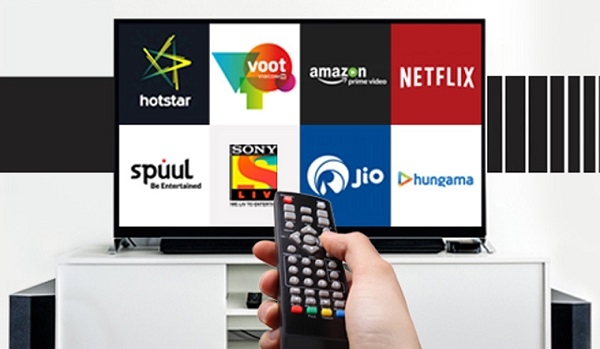OTT- Over the Top or Out of Hand?
Total Views |
- Rishikesh Joshi
OTT has become a household name these days. If you haven’t heard of it, you run the risk of being obsolete. By definition, over-the-top (OTT) is streaming media service offered using the Internet. OTT bypasses traditional cable & Satellite TV platforms. However, it bypasses many more things, which is a worry.
A few years back, when I was working interacting with a company designing TV set top boxes, OTT was a topic for conference room discussions. Most experts didn’t expect OTT to make much inroads into the Indian market. Things changed rapidly in the last couple of years, broadband internet reach to homes multiplied making OTT accessible. While most people used OTT as add on to the traditional TV, many gave away their cable connections.
Past four months of lock down and restrictions saw a multi fold increase in watching movies and serials using OTT applications. The movie theaters were (are) shut, so were the auditoriums. All sports / games shut –no live telecast, studios shut - no new episodes of daily soaps or reality shows. The TV channels ended up dishing out repeat telecasts of old shows. Audience didn’t have much interest to watch the stale content, Ramayan and Mahabharat on DD were perhaps the only exceptions.

In such a situation, the audience turned to OTT and lapped up whatever was being offered through various OTT Apps. As such people had the challenge of utilizing the “at home” time and it came in handy. These days when friends meet on their weekly “Zoom” calls, the major topic is who saw which movie/series on which App and how “hot” it is!
As such OTT had been around for some time, Amazon Fire Stick being one of the popular devices, many other devices caught-up. The devices only offer connectivity; the content was with the App providers. Amazon Prime, Netflix, Hot Star, MX, Voot, Alt-Balaji .. the list of content providers is long and keeps growing. Content in the initial days was Indian movies and old serials. Then came the movies and serials from different parts of the world with dubbing/ subtitles. In a way it was appreciable as it made films and serials of different languages (including Indian) accessible to a large number of Indian viewers. Otherwise it was difficult for a viewer sitting in say Punjab to appreciate a Tamil or Malayalam or a Spanish movie.
These Apps offered two types of content; “free” and “paid”. The revenue stream lied in the “paid” content for which it was necessary to attract viewers and get them hooked on the respective App. The race to get viewers hooked on, caused some distortions which are snowballing. This has become a cause for worry.
The movies released in theaters and serials telecast through satellite/cable TV undergo the guidelines set by CBFC and alike. However, OTT bypasses all of them and such guidelines/ regulations weren’t applicable. The content providers first brought foreign movies and serials, which were made for viewers in those countries. Some of these serials had multiple seasons and episodes and they soon became craze with Indian viewers. The cultural outlook and audience maturity being different, these films/ serials had a lot of content, which would be considered as explicit or obscene here. Maybe that became an “attraction”.
Having tasted success, content providers started producing “exclusive” series by investing substantially in production and enrolling famed artists. Some of them started stretching the limits in the absence of any regulations. Formula was simple, show what cannot be shown in cinema theaters or on Television. The formula involved four elements:
- Sex: Show such explicit scenes that the “A” certificate movies would look like Disney comics.
- Violence: Show gory scenes, the audience should feel excited (or feel like puking).
- Religion: Ridicule the Indian culture, religion and traditions. Show a distorted or perverted form of religious beliefs.
- Language: Use expletives of all genres, no holds barred. Going much beyond the “four letter words”.

Some of those “exclusive” series used all four of above, some three, some two depending upon the inclination of the producer (and stakes involved). Next step was to get the “right” critiques, to put them on high intellectual pedestal with their considered reviews. Few didn’t bother much and went in for experiments like making a series based on popular (?) porn magazine or porn animated comics. If you have seen some of them, the names are obvious and hence I am not listing them.
Some of these series make you wonder if all this is just to gain the viewership (and revenue) or there are ulterior motives? Is it a planned “cultural warfare” like cyber warfare or biochemical warfare? This is where the concerns start growing on the things getting out of hand. It is not as if all the web series are like above. There are many sensible and well-made series. To quote some examples: Panchayat, Kota Factory, Delhi Crime, Bose and many more. How do we protect and encourage these types of series is also a concern?
Questions arises,
- Can we let it go on the way it is now?
- Is there a need to draw a line?
- Is our society matured enough to absorb the unrestricted content or there is a need for a regulatory framework?
Surfing through the news, I understand the authorities had given the content providers 100 days to “self-regulate”. Wonder, if there is will and intent on the part of content providers? Just giving a warning about Violence, Nudity or Language is not adequate, probably it works other way round to attract more people.
Maybe a time has come for authorities to step-in and set-up a regulatory framework. What do you think?

